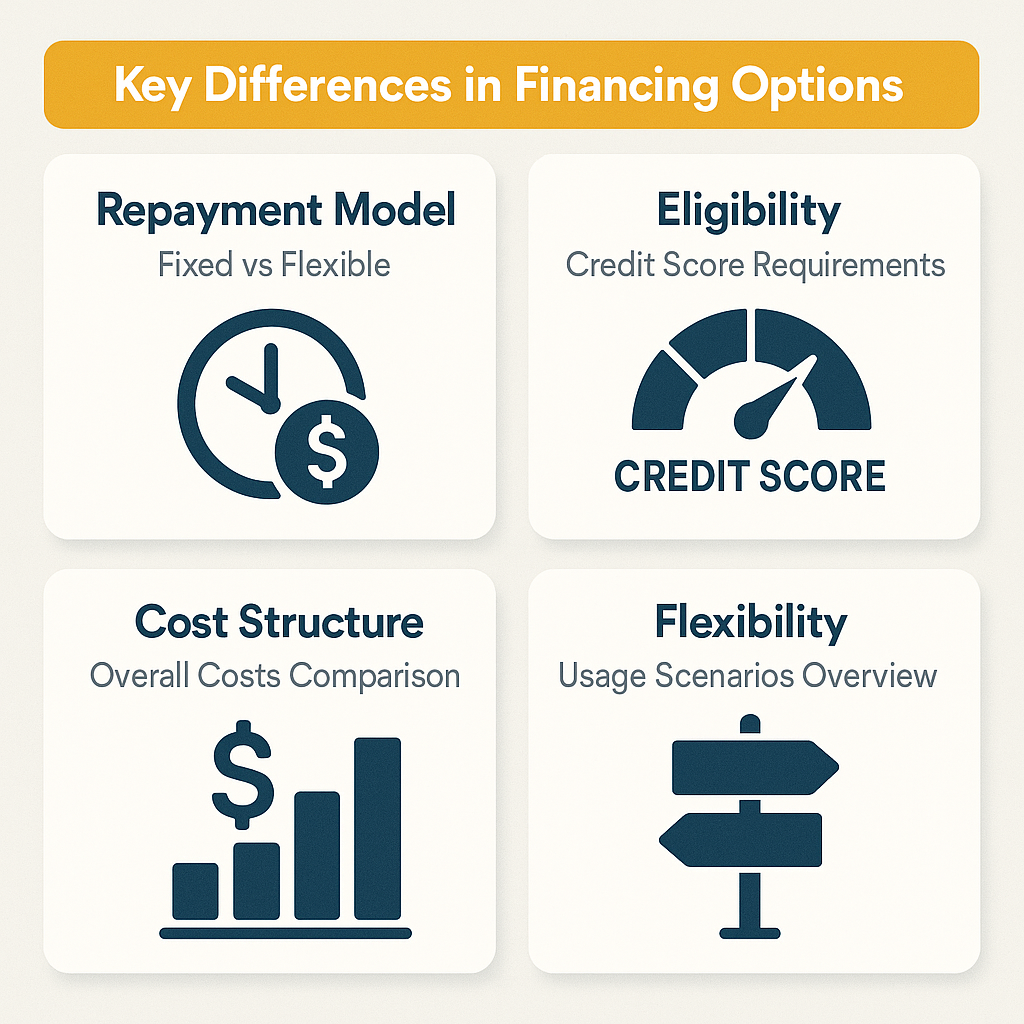Understanding How Merchant Cash Advances Compare to Business Line of Credit Options
When businesses need funding, two popular options often come up: merchant cash advances and business lines of credit. Understanding how merchant cash advances compare to business line of credit options can help you make the right choice for your company's financial needs. Both financing solutions serve different purposes and offer unique advantages depending on your business situation, cash flow patterns, and repayment capacity.
The key differences between these funding options lie in their repayment model, eligibility requirements, cost structure, and flexibility. While business lines of credit typically offer long-term financial flexibility with lower costs, merchant cash advances provide quick access to capital with payments that fluctuate based on your daily sales volume.
Repayment Model Differences That Matter

The repayment model represents one of the most significant distinctions when comparing these two financing options. Each approach aligns with different business cash flow patterns and operational needs.
- Business lines of credit typically require fixed monthly payments with set interest rates, providing predictable repayment schedules that businesses can plan around
- Merchant cash advances offer flexible payments that align with your daily sales volume, meaning you pay more during busy periods and less during slower times
- MCAs collect payments through automatic deductions from credit card transactions, while lines of credit usually involve manual payments or bank transfers
- The percentage-based collection method of MCAs can range from 10% to 20% of daily sales, depending on the agreement terms
- Lines of credit allow businesses to draw funds as needed and only pay interest on the amount used, unlike MCAs which provide a lump sum upfront
Eligibility Requirements and Approval Process
Understanding the different eligibility requirements can help businesses determine which option might be more accessible based on their current financial situation and credit profile.
- Merchant cash advances often have lower credit score requirements compared to traditional lines of credit, making them accessible to businesses with less established credit histories
- Business lines of credit typically require stronger credit profiles, established business history, and detailed financial documentation for approval
- MCAs focus heavily on credit card processing volume and consistency, making them suitable for businesses with regular card transaction activity
- Lines of credit may require collateral or personal guarantees, while MCAs are generally unsecured but secured by future receivables
- The approval timeframe for MCAs can be significantly faster, sometimes within 24-48 hours, compared to weeks for traditional lines of credit
Cost Structure Analysis
The cost structure differs substantially between these financing options, affecting the total amount businesses pay over time and their overall profitability.
- Business lines of credit generally offer lower overall costs with traditional interest rates and transparent fee structures
- Merchant cash advances typically have higher costs due to factor rates rather than traditional interest rates, which can result in higher effective annual percentage rates
- Lines of credit charge interest only on funds actually used, allowing businesses to minimize costs by drawing only what they need
- MCAs involve upfront costs calculated as a factor rate multiplied by the advance amount, with no option to reduce costs through early repayment
- Additional fees for lines of credit might include annual fees, draw fees, or maintenance charges, while MCAs typically have fewer separate fee categories
Flexibility and Usage Scenarios
The flexibility offered by each financing option varies significantly, making certain scenarios more suitable for one over the other based on business needs and operational patterns.
- Business lines of credit provide long-term financial flexibility for ongoing operational needs, equipment purchases, and managing seasonal fluctuations
- MCAs work best for businesses with variable cash flows and frequent card transactions, particularly in retail, restaurants, and service industries
- Lines of credit allow businesses to access funds multiple times up to their credit limit, while MCAs typically require full repayment before accessing additional advances
- The revolving nature of lines of credit makes them ideal for businesses that need periodic access to capital throughout the year
- MCAs align well with businesses experiencing sales variability since payments automatically adjust to revenue fluctuations
Making the Right Choice for Your Business
Selecting between these financing options requires careful consideration of your business's specific circumstances, financial goals, and operational characteristics.
- Choose a business line of credit if you need ongoing access to funds, have strong credit, and want lower long-term costs with predictable payments
- Consider a merchant cash advance if you need quick funding, have inconsistent credit, and can benefit from payments that fluctuate with sales volume
- Evaluate your credit card processing volume and consistency, as businesses with regular card transactions may find MCAs more suitable
- Consider your ability to make fixed payments versus the flexibility of variable payments that align with your sales patterns
- Strengthen your financial documents and understand lender criteria to improve approval odds regardless of which option you pursue
Understanding how merchant cash advances compare to business line of credit options enables you to make informed financing decisions that align with your company's needs. Each option serves different purposes: lines of credit offer long-term flexibility with lower costs for established businesses, while merchant cash advances provide quick access to capital with flexible repayment for businesses with variable sales patterns.
The choice between these financing options ultimately depends on your business's credit profile, cash flow patterns, and specific funding requirements. Consider factors like repayment flexibility, cost structure, eligibility requirements, and your ability to manage different payment schedules when making your decision.

.png)






